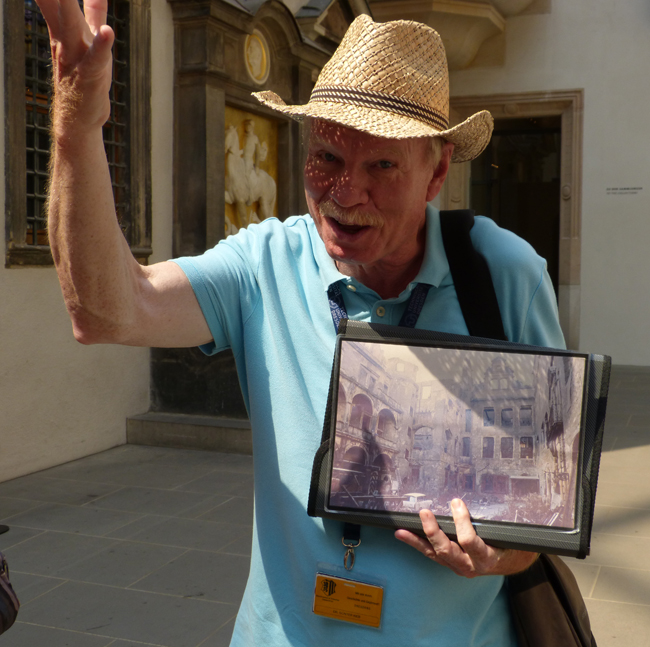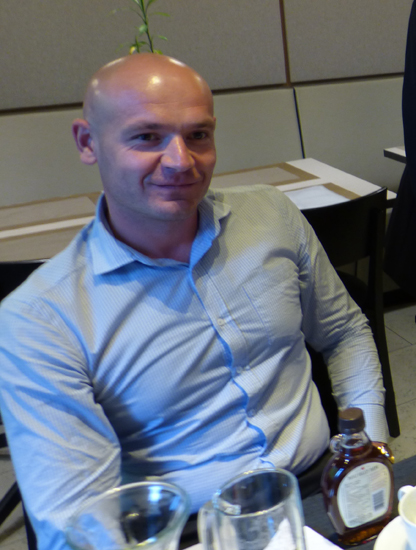
We were meeting for the very first time. I wanted to give my new acquaintance a gift that reflected where I came from and made a friendly first impression. I reached into my pocket and pulled out a souvenir. It was a lapel pin with the Canadian flag on it.
“Here,” I said, “please have a symbol of Canada – our flag pin.”
My acquaintance, one of the guides on our recent tour to Eastern Europe, looked back at me and said, “But I’m German,” meaning, “Why would I wear a pin that doesn’t represent who I am?”
I had to admit that Günter Kieb, our guide in Dresden, Germany, was absolutely correct. Why would a middle-aged German wear the emblem of Canada? Some hours later, however, when I was thanking Mr. Kieb for his service to us that day, I reminded him (and our touring group) that he had seemed perplexed by my Canada flag pin. “Not a problem,” I said. “But how about this?” And I pulled a small flask-shaped bottle from my backpack and gave it to him.
Günter’s eyes widened with delight. “Canadian whisky?” he asked.
“No. Better,” I laughed. “It’s maple syrup!”
It took a bit of explaining from several members of our Canadian group and from our multilingual guide, but Günter realized it was a food delicacy and he seemed happy.
I have travelled abroad for many years, often relying on the knowledge and hospitality of non-Canadians to assist our tours to get the most from our visits. And people particularly in the service industry, get it. They realize that leaving a positive impression on visitors boosts the reputation of an attraction, a city and ultimately a country’s tourist economy. In return, we have often offered Canadian gifts – books, caps, mittens, scarves, T-shirts and friendship pins. But without question, maple syrup has left the deepest impression.
We’ve given this national delicacy to a principal in Pachino, Sicily, where the entire population of the middle school turned out to thank the vets in our group who’d liberated Italy in 1943-44. We gave a bottle to a Dutch troubadour who every week for 60 years tended the grave of a Canadian soldier who’d saved his family from starvation in the Hunger Winter of 1944-45.
We’ve given maple syrup to a retired dentist in Normandy; the man had assisted Canadian veterans secure the land on which the Juno Beach Centre museum now resides. As with my Dresden guide Günter, not every recipient of this maple tree nectar understood its function, but we’ve always had sufficient translation capability to offer ideas for its unique usage.

On this most recent trip to Eastern Europe, I kept one bottle of maple syrup for our special guide in Berlin. Kathrin Hadba led us to many of the historic Second World War sites that Berlin has preserved – places such as the former Gestapo headquarters (now a museum to the victims of the Holocaust), to Wannsee where the Nazis plotted the extermination of Europe’s Jewish population, the so-called “final solution,” and to Potsdam, where the leaders of the three Allied nations – Stalin, Truman and Churchill – carved up Europe at the end of the war.
We learned along the way that Kathrin also loved the Rolling Stones (she was attending one of their concerts Friday night) and food. So, it seemed that maple syrup would be a perfect gift. Then, came my presentation. Like Günter, she too was a bit perplexed as to what to do with the stuff in this bottle. Until one in our group offered a most appropriate means of enjoying it.
“Put it on ice cream,” one of our travellers said.
And just like Günter (thinking it was whisky), Kathrin’s face lit up and she could hardly wait to try it.
On the final day of our recent Eastern European trip, we enjoyed a farewell supper among our travellers and service crew. We thanked Edward Foster, our guide during the tour, and offered him some Canadian ice wine in gratitude.

Then, I turned to our bus driver. Yashek, who is Polish, had barely said a word all through the trip, but he’d safely driven us across Poland, the Czech Republic to Berlin in Germany. He spoke no English. He spoke Polish and some Italian. Our guide spoke Italian. So, Edward took my words offering Yashek the maple syrup in English, translated them to Italian, and waited for a response from Yashek.
“It’s a delicacy,” I said. And since it had worked for Kathrin, I added, “to put on ice cream!”
When he got the Italian translation, his face lit up too. It wasn’t so much the emblematic sweetener from Canada’s sugar bush that intrigued him, but the thought of putting it on ice cream. And that seemed even more succinct than any Polish, Italian or Canadian label could define.